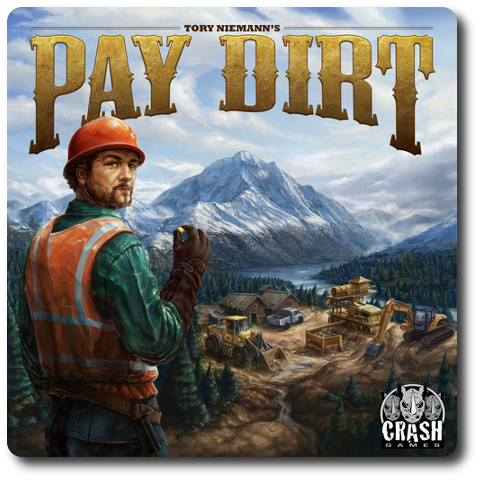
The Basics:
- For ages 8 and up (publisher suggests 13+)
- For 2 to 5 players
- Approximately 90 minutes to complete
Geek Skills:
- Active Listening & Communication
- Counting & Math
- Logical & Critical Decision Making
- Reading
- Strategy & Tactics
- Risk vs. Reward
- Hand/Resource Management
- Auctioning, Bidding, & Trading
- Worker Placement
Learning Curve:
- Child – Moderate
- Adult – Easy
Theme & Narrative:
- No great reward comes without great risk
Endorsements:
- Gamer Geek approved!
- Parent Geek approved!
- Child Geek approved!
Overview
American author, speaker, and pastor, John C. Maxwell, said “Success comes to those who have an entire mountain of gold that they continually mine, not those who find one nugget and try to live on it for fifty years.” Once you find gold, it’s not enough to hold it up for the world to see. There is more to be obtained. In this game, there is wealth to be found, but only for those who persevere.
Pay Dirt, designed by Tory Nieman and published by Crash Games, is comprised of 5 “Mining Camp” Player boards, 1 game board, 18 Equipment tiles, 18 Personnel cards, 30 Hardship cards, 18 Claim tiles, 5 Greenhorn Claim tiles, 14 Gear tiles, 63 Pay Dirt tiles, 80 Money tokens, 60 Wear cubes (red), 35 Gold Nuggets (small), 25 Gold Nuggets (large), 50 Worker meeples, 1 Head Miner token, 1 “No Bid” token, and 1 Temperature token (blue). The component quality is excellent, with thick game boards, durable cards, and wooden bits. The artwork by Darrell Louder and Naomi Robinson is outstanding, capturing the rugged beauty of the landscape and the hardships of working in remote areas of the Alaskan wilderness.
Arriving in the Wilderness
To set up the game, first place the game board in the middle of the playing area. Place the blue Temperature token on the “15°c” value found on the game board’s left-most side. This is the Temperature track. Watch it closely.

Second, shuffle the Pay Dirt tiles and place them near the game board face-down in stacks according to type. There will be a stack for “Rich” Pay Dirt, “Promising” Pay Dirt, and “Barren” Pay Dirt.
Third, shuffle the Equipment tiles, Personnel cards, and Claim tiles separately. Place each face-down in a pile on their designated areas found on the game board. These are the Equipment, Personnel, and Claim draw piles for the duration of the game. Draw the top-most card or tile for each pile and place it face-up and below their draw piles (placing the it below and off the game board). This area below the game board is referred to as the “Auction House”. Repeat until there are 3 of each in the Auction House.
Fourth, shuffle the Camp and Claim Gear tiles together. Deal 5 face-up in a column to the right and next to the “Gear Supplier” area on the game board. Place the remaining tiles face-down above the column of tiles just placed.
Fifth, shuffle the Hardship cards and place it face-down above the game board. Next to it, create pools for the Gold Nuggets (both large and small), Money tokens, Worker meeples, and Wear cubes. I suggest you use small cups to help keep everything organized.
Sixth, give each player 1 “Mining Camp” Player board. These are placed in front of the player. In addition, give each player 5 Workers in their preferred color, 1 Greenhorn Claim tile (that matches their meeple color), 3 “Barren” Pay Dirt tiles (which are placed on the Greenhorn Claim tile and SHOULD NOT be looked at), and $9000 worth of Money tokens.
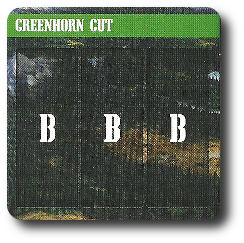
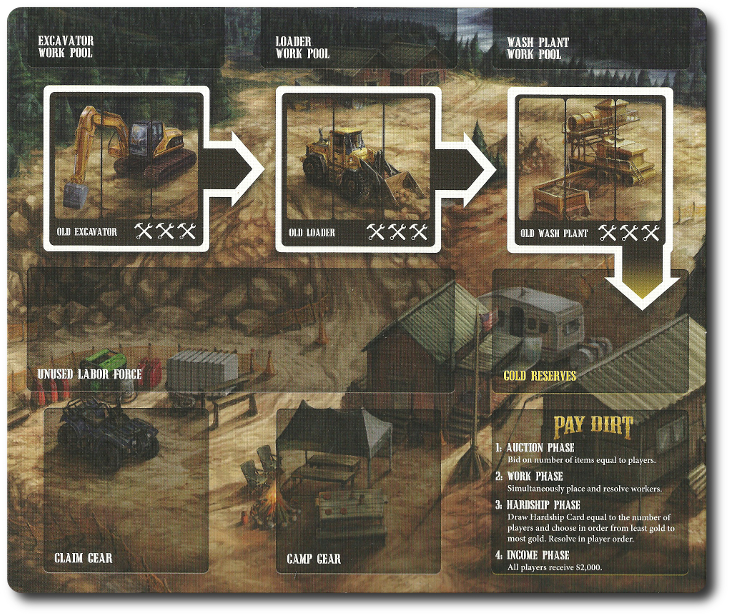
That’s it for game set up. Determine who will be the first player and give them the Head Miner token.
Grit, Grind, and Gold
Pay Dirt is played in rounds with no specific number of rounds per game. A game round is comprised of 4 phases which are summarized here.
Phase 1: Auction
The player who currently has the Head Miner token is the “Auctioneer” for the round. The Auctioneer chooses 1 face-up card in the Auction House and announces their bid on it. The amount bid must be equal to or higher than the noted minimum cost. Each player, in turn order sequence, must now bid higher than the previous bid or pass. Passing removes the player for the duration of the auction for the current item, not the phase. If a player makes a bid, they must be able to pay for it.
The auction continues until only 1 player’s bid remains (all other players have passed). The winner pays their bid amount, takes the item that was bid on, and then places the No Bid token on the face-down pile of cards for that specific category. A new card is not drawn to replace the claimed one until the next round.
If the Auctioneer won the last bid, then the next player to the Auctioneer’s left that has not yet won a bid is the new Auctioneer. The process is then repeated. The only limitations is that the Auctioneer cannot bid on an item category bid on during the last auction (as indicated by the No Bid token). If the next Auctioneer cannot pay the minimum cost, they must forfeit their turn as Auctioneer.
The Auction phase continues until a number of items equal to the number of players have been auctioned off or until all players are unable to or are ineligible to become the next Auctioneer. If all players pass, then the Auction phase ends, as well.
Using Won Items
Any items won during the Auction are placed to the player’s “Mining Camp” Player board.
- Claims are placed to the left of the player’s Mining Camp and filled with Pay Dirt tiles (Pay Dirt tiles should always be placed face-down and NOT looked at).

- Personnel are placed to the right of the player’s Mining Camp. Then the number of listed extra Workers are added and included in the player’s Unused Labor Force pool. Any special abilities noted on the card can be used immediately.
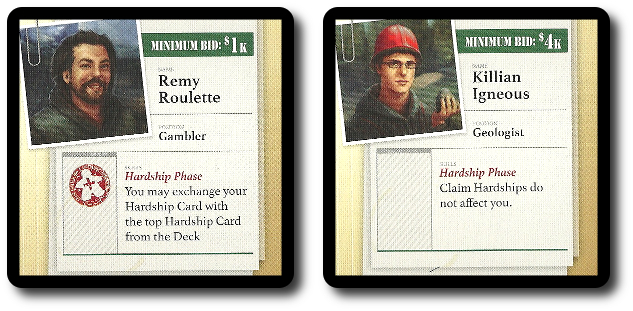
- Equipment are placed on top of Equipment space of the matching type, replacing previously placed items. Any Wear cubes on previous equipment are removed. Any Pay Dirt tiles are moved to the equivalent stage of the new Equipment.
 Optionally, equipment can also be stripped for parts instead of upgrading or replacing older equipment. A number of Wear cubes equal to the newly acquired Equipment card’s Durability rating are removed. This allows players to buy downgraded equipment for parts to fix upgraded equipment.
Optionally, equipment can also be stripped for parts instead of upgrading or replacing older equipment. A number of Wear cubes equal to the newly acquired Equipment card’s Durability rating are removed. This allows players to buy downgraded equipment for parts to fix upgraded equipment.
Phase 2: Work
During this phase, players will be assigning their Worker meeples to specific areas on the main game board in the middle of the playing area and their own “Mining Camp” Player board. This can be done simultaneously, but is best done in turn order sequence starting with the Head Miner going first to avoid conflicts.
Assign Workers
Each player now takes their Worker meeples and assigns them to use equipment, make repairs to equipment, buy gear, or sell gold. Each assigned area provides a specific action.
- Sell Gold: Each Worker meeples in the “Sales Office” may sell up to 2 Gold Nuggets for $3000 each.
- Buy Gear: Each Worker meeple in the “Gear Supplier” may buy 1 face-up Gear tile (Claim Gear or Camp Gear) for its face-up value. Gear is added to the player’s “Mining Camp” Player board. Gear can be used once per round during the Work phase.
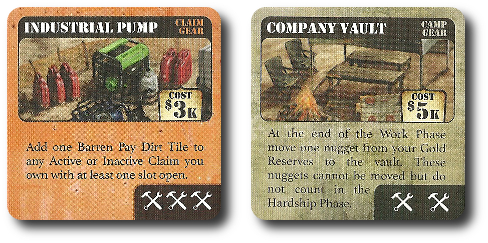
- Use Equipment: Each Worker meeple placed on one of the Worker pools (Excavator, Loader, and Wash Plant) can move 1 Pay Dirt tile to the next stage.
- Make Repairs: Each Worker meeple assigned to repair equipment can remove up to 2 Wear cubes from a single piece of equipment or gear currently owned by the player.
Use Workers
Starting with the Head Miner, each player can use one or more Worker meeples in their assigned area for the action it pertains. The Worker meeples are removed and placed back in the player’s Unused Labor Force pool. A player can also decide to remove Worker meeples without activating the action.
All actions are resolved simultaneously with the exception of buying gear which is done in turn order sequence and resolved one Worker meeple at a time.
Phase 3: Hardship
The player with the least amount in their Gold Reserve now draws a number of Hardship cards equal to the number of players. The player then reviews the cards they drew, selects 1 Hardship card to keep, and places it face-down in front of them. They then pass the remaining cards to the opponent with the next least amount of gold in their reserve. This player now does the same thing, selecting 1 Hardship card, placing it face-down in front of them, and passing the remaining cards to the next opponent with the least amount of gold in their reserve. This continues until each player has a Hardship card. The Head Miner will always be given the last Hardship card during the first round.
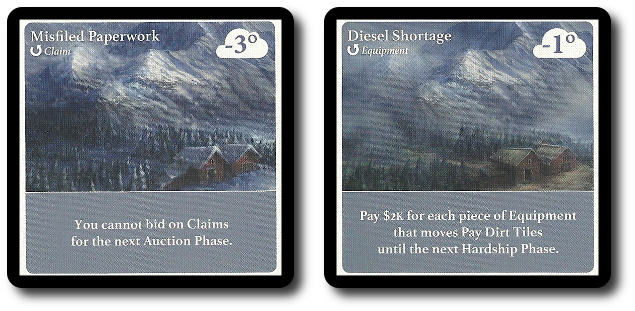
All players then reveal their Hardship cards and resolved them simultaneously. Hardship cards will either remain with the player until the next Hardship phase or be resolved and discarded immediately. A Hardship card will either target a player’s equipment, personnel, or claim. Some Personnel cards purchased by players can counteract certain Hardship cards or not apply.
Finally, the Temperature token is moved down a number of degrees equal to the number indicated on the Hardship card given to the Head Miner. In this way, players need to consider which Hardship cards they are giving to each other, balancing the necessity to hamstring opposition with the need to ensure the game does not end prematurely.
Phase 4: Income
After working hard and suffering through bitter temperatures, it’s time to get paid! Each player receives $2000 from the common supply.
Then the Equipment, Personnel, and Claim tiles and cards are restocked in the Auction House from their specific piles. There should be 3 of each type when completed. Remove the No Bid token and set it aside. Gear is also resupplied so there are 5 face-up Gear tiles up for grabs.
Finally, the Head Miner token is passed to the next opponent going in turn order sequence. The round is now over and a new one begins starting with phase 1.
Wear, Dirt, and Gold
Players will be using a lot of equipment to scoop up dirt, dig, and go through the soil and rock to look for gold. Equipment is purchased new, but the constant work quickly wears them down. The damage and general stress on the equipment is tracked with Wear cubes. Each time a piece of Equipment transfers a Pay Dirt tile to the next piece of Equipment, a Wear cube is added. In this way, the more the player uses their Equipment, the more it starts to wear out. If the number of Wear cubes on the piece of Equipment is equal to the Equipment’s Durability rating, the player cannot move Pay Dirt tiles to it, essentially stopping the process of finding gold.
All Pay Dirt tiles first come from a player’s Claim. It then moves to Excavator, followed by the Loader, and then the Wash Plant. From the Wash Plant, any gold the Pay Dirt provided is placed in the player’s Gold Reserve. Keep in mind that a player does not know how much gold, if any, will be given to them until they pass the Pay Dirt tile through the entire process. Players can begin to process a Pay Dirt tile from any Claim tile they currently own, but can never “leapfrog” another Pay Dirt tile. The entire time to process a single Pay Dirt tile depends on how many Pay Dirt tiles are in front of it, the number of workers available, and how many steps are included. Even then, when the Pay Dirt is washed and flipped over, it might not result in much (if any) gold.
Final Round and Winning the Game
If the Temperature track falls to “0°” or lower, the next round of game play will be the last. The only difference between the final round and the previous rounds is that the Hardship and Income phases are skipped, with a new phase introduced to replace them.
During the final round, phase 3 is reserved for the Final Clean-Out. Only players who still have Pay Dirt tiles remaining on their Equipment tiles can participate in this phase. This is, essentially, a last-ditch effort to earn some much-needed gold. The right-most Pay Dirt tile closest to the end of the Wash Plant stage of the player’s “Mining Camp” are revealed. The player earns a number of Gold Nuggets on the Pay Dirt tile minus 1 Gold Nugget for each stage remaining until the end of the line.
All players now count their collected Gold Nuggets. The player with the most Gold Nuggets wins the game.
Game Variant
Two-Player Game
If only playing with 2 players, the game play is a bit different from what I summarized above. Set up the game as you would normally. After the first round of game play, remove the bottom most tile/card of each item in the Auction House. These are placed back in the box and our out for the duration of the game.
To learn more about Pay Dirt, visit the game’s web page.
Final Word
The Child Geeks were able to quickly grasp the game’s concept, but struggled during the auctions. From what we observed, the main issue appeared to be one of “perceived value”. The Child Geeks had difficulty determining if an item was worth while or exactly what they needed. According to one Child Geek, “The hardest part of the game is when you have to buy things. I never know if what is being offered is worth getting or not.” As the game progressed, the Child Geeks began to learn what was needed and why. Their second and third games always demonstrated a much more savvy auction with clear intent to address current or possible future shortcomings. As one Child Geek put it, “Once you understand how everything works together, buying things is really easy.” When the gold was cleaned and counted, the Child Geeks all voted to approve Pay Dirt.
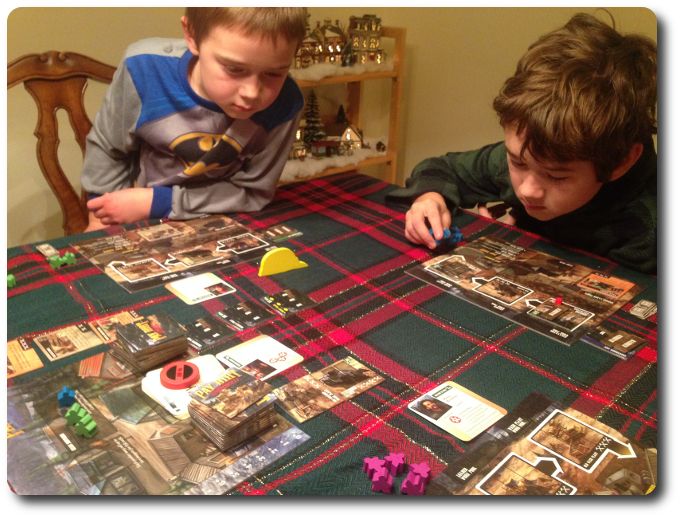
Auctions were intense, but so were the placement of Workers
The Parent Geeks understood the value of the items being auctioned much faster than the Child Geeks, demonstrating logical purchases and strategic acquisitions for their Mining Camp. According to one Parent Geek, “The best part of this game is managing the camp. It’s fun to move your dirt forward and you get excited when you are about to determine how much gold you find.” Another Parent Geek said, “The harsh environment and the competition for the same resources makes the game feel tense, but the real focus is always on your own claims. I like that.” The Parent Geeks all voted to approve Pay Dirt, finding it to be a game that quickly engaged their curiosity, latched onto their interests, and offered entertainment from start to finish.
The Gamer Geeks were impressed with Pay Dirt, finding it to be a game that challenged their logical and critical thinking, but continually required a revision in their strategic and tactical game play. According to one Gamer Geek, “This game is doing it right. Its set up is simple and its execution is clean. The true emphasis of the game is on the decisions being made and the outcomes of choices. I really like that.” Another Gamer Geek said, “I find the auction to be a bit clunky, but very workable. The most interesting aspect of the game is refining your own Mining Camp process to be as efficient as possible, while weathering the elements.” The Gamer Geeks were most pleased with Pay Dirt and fully approved it for their elitist gaming table.
There is a moderate learning curve in this game for the Child Geeks and pretty much anyone who hasn’t played games before where there is a strong auction mechanic. Like real life auctions, the goods and services offered in the game go to the highest bidder. The minimum price listed on the card or tile, however, does not necessarily accurately suggest its importance. It’s simply a noted starting point. This was found to be misleading and caused troubles for the Child Geeks, as they kept assuming that the more something was worth, the better it was in the game.
In reality, the “value” of the item is highly subjective. I noted several times that an individual player purchased a piece of equipment or worker that had zero value for me. And yet, with their acquisition, they were able to excel. This always made me smile because it suggested that the game offered all players an opportunity to identify any shortcomings they might have and address them. If a player didn’t think they needed the item being auctions, they just avoided it. The trick is knowing what you do or do not need.
Short of deciding which flannel shirt to wear and how many pancakes to eat in the morning, I really felt that I was making important decisions for a mining camp. It’s all about making money and to do that, you need to cut corners, save where you can, and take calculated risks. Cheap equipment will get the job done, but not quickly. Cheap claims will provide gold, but not rich deposits. More workers makes for lighter work, but can lead to assignment problems. Through it all, a player is tasked to continually reevaluate their situation and adjust. The decisions to be made are not always obvious or easy.
I really enjoyed Pay Dirt. Its presentation is outstanding and the game play is smooth. It challenged players and myself to consider goals both in the short and long-term, to take risks, address faults, and painfully sell gold. If this game taught me nothing else, it’s that mining in the Alaskan Wilderness is nothing short but brutal. The elements are against you, time is not on your side, and Murphy’s Law trumps all. I had a blast. When I gained a lot of gold I wanted to jump up and down and when I had to sell it to fix the washer for the 6th time, I practically wept. But in a good way.
Do try this game when time allows. It will challenge and entertain you in equal measure. Before the game is over, you’ll find yourself licking your lips as a Pay Dirt tile exits the washer and can be revealed. At which point, get ready to shout “I’M RICH!” or “I BROKE TWO PIECES OF EQUIPMENT FOR THIS?!?!” Either way, I think this is a game you’ll dig.
This game was given to Father Geek as a review copy. Father Geek was not paid, bribed, wined, dined, or threatened in vain hopes of influencing this review. Such is the statuesque and legendary integrity of Father Geek.



